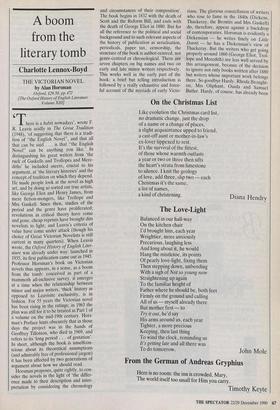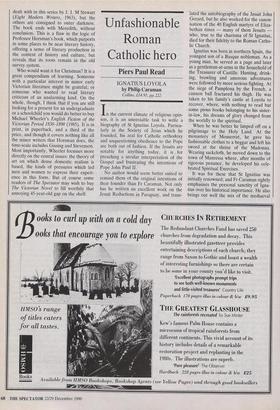A boom from the literary tomb
Charlotte Lennox-Boyd
THE VICTORIAN NOVEL by Alan Horsman
Oxford, 129.50, pp.472 [The Oxford History of English Literature Volume X111]
here is a habit nowadays', wrote F. R. Leavis acidly in The Great Tradition (1948), 'of suggesting that there is a tradi- tion of "the English Novel", and that all that can be said . . . is that "the English Novel" can be anything you like.' In distinguishing his great writers from 'the ruck of Gasket's and Trollopes and Mere- diths' he included sneers, crucial to his argument, at 'the literary histories' and the concept of tradition on which they depend. He made people look at the novel as high art, and by doing so sorted out true artists, like George Eliot and Henry James, from mere fiction-mongers, like Trollope and Mrs Gasket'. Since then, studies of the period and the genre have proliferated; revolutions in critical theory have come and gone; cheap reprints have brought dim novelists to light; and Leavis's criteria of value have come under attack (though his choice of Great Victorian Novelists is still current in many quarters). When Leavis wrote, the Oxford History of English Liter- ature was already under way: launched in 1935, its first publication came out in 1945. Professor Horsman's book on Victorian novels thus appears, in a sense, as a boom from the tomb: conceived as part of a mammoth all-inclusive survey, it emerges at a time when the relationship between minor and major writers, 'thick' history as opposed to Leavisite exclusivity, is in fashion. For 55 years the Victorian novel has been rising in the ratings; in 1963 the plan was still for it to be treated as Part 1 of a volume on the mid-19th century. Hors- man's Preface hints obscurely that in those days the project was in the hands of Geoffrey Tillotson, who died in 1969, and refers to its 'long period . . . of gestation'. In short, although the book is unselfcon- scious about its theoretical assumptions (and admirably free of professional jargon) it has been affected by two generations of argument about how we should read.
Horsman proposes, quite rightly, to con- sider the novels in the light of 'the differ- ence made to their description and inter- pretation by considering the chronology and circumstances of their composition'. The book begins in 1832 with the death of Scott and the Reform Bill, and ends with the death of George Eliot in 1880. But for all the reference to the political and social background and to such relevant aspects of the history of publication as serialisation, periodicals, paper tax, censorship, the structure of the book is author-centred, not genre-centred or chronological. There are seven chapters on big names and two on early and late minor writers respectively. This works well in the early part of the book: a brief but telling introduction is followed by a really exhaustive and force- ful account of the myriads of early Victo-
rians. The glorious constellation of writers who rose to fame in the 1840s (Dickens, Thackeray, the Brontes and Mrs Gasket]) do, therefore, appear against a backdrop of contemporaries. Horsman is evidently a Dickensian — he writes finely on Little Dorrit — he has a Dickensian's view of Thackeray. But the writers who get going properly around 1860 (George Eliot, Trol- lope and Meredith) are less well served by this arrangement, because of the decision to ignore not only books written after 1880 but writers whose important work belongs there. So goodbye Hardy, Rhoda Brought- on, Mrs Oliphant, Ouida and Samuel Butler. Hardy, of course, has already been dealt with in this series by J. I. M Stewart (Eight Modern Writers, 1963), but the others are consigned to outer darkness. The book ends with Meredith, without conclusion. This is a flaw in the logic of Professor Horsman's book, which purports in some places to be near literary history, offering a sense of literary production in the context of history and culture, but reveals that its roots remain in the old survey system.
Who would want it for Christmas? It is a great compendium of learning. Someone with a particular interest in minor early Victorian literature might be grateful; or someone who wanted to read literary criticism of an unalarming kind. On the whole, though, I think that if you are still looking for a present for an undergraduate or a schoolchild you would do better to buy Michael Wheeler's English Fiction of the Victorian Period 1830-1890 (1985). It is in print, in paperback, and a third of the price, and though it covers nothing like all the minor writers that Horsman does, the time-scale includes Gissing and Stevenson. Most importantly, Wheeler focusses more directly on the central issues: the theory of art on which dense domestic realism is based, the kinds of pressures which led men and women to express their experi- ence in this form. But of course some readers of The Spectator may wish to buy The Victorian Novel to fill worthily that annoying 45-year-old gap on the shelf.



































































































 Previous page
Previous page